#effective nuclear charge trend
Explore tagged Tumblr posts
Text
The atomic radius, shielding, and the lanthanide contraction
As you hopefully already know, there are several trends of the elements' properties that you can squeeze out of the periodic table. The one I want to focus on in this post is the atomic radius.
The shorter and simpler explanation is as follows: if you move from the top to the bottom, the radius increases, which is simply the result of more electron shells (“layers”) being added to the atom. Moving left to right, the radius decreases and that is caused by the growing positive charge of the nucleus attracting the valence electrons more strongly like the swole doge and therefore shrinking the atom.
But chemistry is a science, and the sciences are beautifully complex, so let me tell you about this one intricacy affecting the radius. We’re going to need some knowledge of the electronic structure of an atom, but I'll try to fit all that you really need to know inside a single paragraph.
The compact version is this: inside the atom, there are little pockets of space where electrons can be, so to say. Those pockets are called orbitals and they have all sorts of funky shapes. The s orbitals, for example, are ball-shaped, while the p orbitals look roughly like balloons attached to the nucleus. (They're sometimes described as dumbbell-shaped. What sort of dumbbell looks like that. They're balloons.)

[source]
Back to the radii! I'm going to use the second period as an example here, but there's nothing special about it. It just happens to be quite a simple case. Lithium and beryllium only have s orbitals, so that's not very interesting, but the rest of the period has both s and p orbitals.
As we move from lithium, across the whole period, and to fluorine (there's no need to engage the noble freaks), three important things happen: the radius decreases, each next element has one more proton in the nucleus than the previous one, and also each next element has one extra valence electron. Duh. The number of electrons "inside" doesn't change, it's only the outermost shell that gains electrons.
But remember, an electron is not a marble sitting in one point at all times. When it comes to electrons in atoms, it's better to imagine them as lil clouds of negative charge in the shape of their respective orbitals. As a result, the core electrons obscure the nucleus from the valence electrons. Not entirely! But the attractive force felt by the valence electrons isn't just equal to whatever Coulomb's law would give us - it's a bit smaller. This is called the shielding effect and the charge that valence electrons actually "feel" from the protons in the nucleus is called effective nuclear charge. The atomic radius is therefore a tad bigger than we could assume without acknowledging shielding (but the trend of a decreasing atomic radius across the periodic table still stands, of course).
So, what about the lanthanides, those poor, misunderstood outcasts thrown under the periodic table?

God I love pubchem's periodic table it's so pretty!
There's no plot twist here, they don't break the trend. Cerium is the biggest one, lutetium the smallest. So what gives? See, lanthanides begin filling up their f orbitals, whose shapes are so absurd even I am afraid of them.
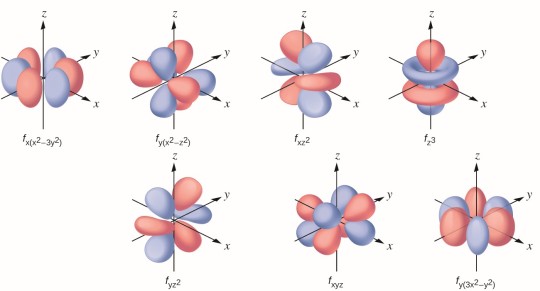
[source]
Because they're so ridiculous, they are supremely bad at shielding the positive charge of the nucleus, which in turn makes the lanthanides significantly smaller than they would be if this effect didn't take place - so much so that we call this phenomenon the lanthanide contraction. Actually, the f orbitals suck at shielding so bad that the radii of the (d-block) metals of the sixth period are very similar to the radii of the elements in the period above them - even though they should be much larger!

[source]
Really. Chemistry is like psychology for electrons. Everything that happens here is caused by these guys' weird behavior.
#gee i finally finished it#you don't want to know how long this has been sitting unfinished in my drafts#mine#op#studyblr#chemblr#chemistry#stemblr#sciblr#science
78 notes
·
View notes
Text
Periodic table structure

arranging periodic table into blocks, we see that as you go left to right, top to bottom, it follows the increasing energies of subshells w/c occur due to increasing amounts of electron shielding (e.g. 4s → 3d)
n = row number
columns are grouped by l (b/c it indicates s, p, d, or f subshell)
s block elements have outermost electrons in s subshell
p block elements have outermost electrons in p subshell
d block elements have outermost electrons in d subshell
f block elements have outermost electrons in f subshell; f-block elements = lanthanides and actinides and they actually insert themselves here:

rows aka periods = principal quantum number n
Periodic table trends = based on Coulomb's law:
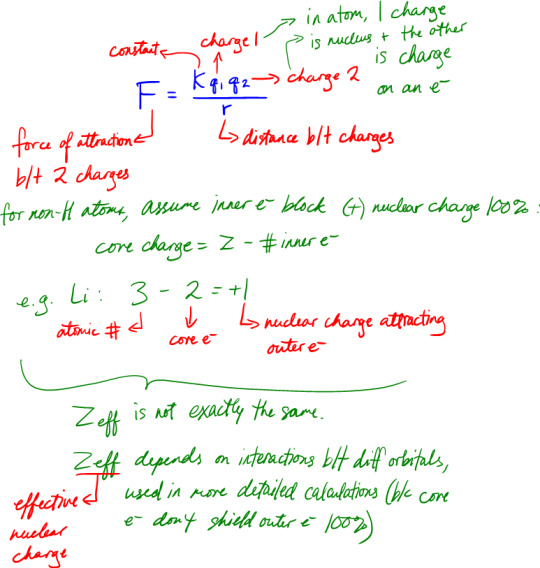
We can't calculate r exactly because of quantum mechanics, so we need to use a mean r value to calculate force of attraction between nucleus and an electron.
Core charge = change experienced by outermost electrons of an atom, assuming the inner electrons shield them 100% from the nucleus and outermost electrons don't shield each other at all.
Ignoring transition metals, core charge = group number (+1 to +8).
In reality, orbitals of outer electrons somewhat penetrate inner orbitals so effective shielding isn't 100% and electrons in the same shell can partially shield each other somewhat. So the actual amount of shielding and effective nuclear charge depends on interactions between different orbitals (e.g. s orbitals have more electron density near or on the nucleus than a p orbital with the same n, so s orbitals shield the nucleus better and is less affected by shielding from other orbitals than p). The actual amount of shielding isn't the same as the amount of shielding assumed in core charge calculations, and thus, the effective nuclear charge does not exactly equal core charge.
Atomic radii
Core charge increases as you go left to right w/c means 1 of the q's in Coulomb's law is increasing, assuming everything else is the same; core charge = one's place of group #. This means force of attraction between outer electron and nucleus increases as you go left to right because the higher the core charge, the more strongly the nucleus pulls the outer electrons towards itself. This means atomic radii decrease from left to right.
As you go down the periodic table, atomic radii increase because you increase in number of energy levels with each period (n ↑).
So largest atomic radii are at the bottom-left of the table.
Ionization energy
Ionization energy = amount of energy (ΔH) that must be absorbed to remove an electron from an atom, to turn the atom into an ion (M → M+ + e-)
We tend to measure energy in enthalpy, so energy = ΔH
The more loosely an atom holds its electrons, i.e. the more electron shielding there is, and therefore the larger the atomic radii, the lower the ionization energy because it's easier for an electron to be removed.
The more tightly an atom holds it's electrons, i.e. the less shielding their is, the smaller the atomic radii, the higher the ionization energy.
So the highest ionization energies are at the top-right of the table (except noble gases because they have full valence shells).
First ionization energy - an outermost electron is removed first
Second ionization energy - a 2nd electron is removed after the first, w/c is always higher than the first because there's greater attraction to nucleus with fewer electrons in the way
You can also have third, 4th, etc. ionization energies, it just depends how many electrons in the atom you have that you want to remove
Sometimes the difference b/t 1st and subsequent ionization energies is small, sometimes it's a really big difference. Difference is really big when you go from outer electrons to core electrons. Difference is small when you're just dealing with outer electrons
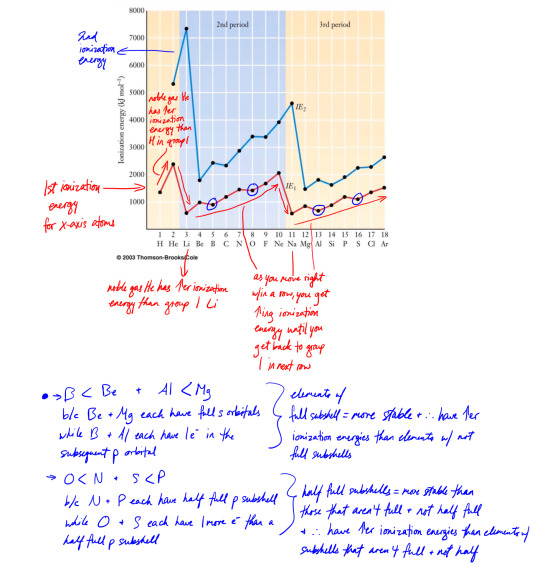
Electron affinity
Electron affinity is the amount of energy (ΔH) released when adding an electron to an atom (M + e- → M-)
All atoms have negative electron affinity except noble gases, so they all can take more electrons except for noble gases, but elements with the highest electron affinity are in the top-right of the periodic table (they tend to form anions)
Metals tend to have low ionization energy and low electron affinity, becoming cations
Non-metals tend to have high ionization energy and high electron affinity, becoming anions
So metals + non-metals → ionic compounds
Metalloids/semimetals can act metallic or non-metallic depending what they're paired with
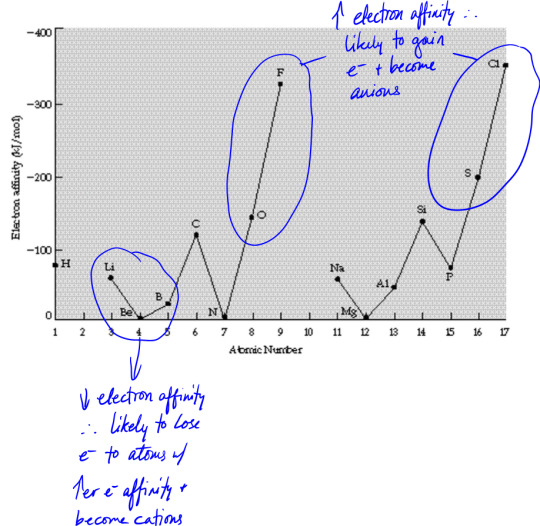
Electronegativity
Electronegativity is how likely is an atom that shares an electron pair w/ another atom going to attract that pair to itself vs attracted away from it to the other atom and where the electrons spend most of their time? When high electron affinity elements form a covalent bond, they are more likely to hog electrons aka have high electronegativity.
Reactivity

group 1A / alkali metals → lose 1 electron, often form salts (react w/ halogens), reactivity increases as you go down the group
group 2A / alkali earth metals → lose 2 electrons, tends to react with atoms that gain 1 or 2 electrons
group 3A → tend to form 3+ ions except B b/c that would make it very unstable (instead, B forms covalent bonds)
group 4A → C and Si both form tetrahedral structures but Si can have more complex molecule geometries b/c it has d orbitals and tends to lose electrons like metals (hence, it's a metalloid), while C can lose or gain electrons
group 5A → N and P are non-metals forming 3- ions, As and Sb are metalloids so can go either way, Bi is a metal that tends to lose electrons b/c it's a large atom so low ionization energy
group 6A / chalcogens → O, S, and Se are non-metals that can form 2- anions, Te is a metalloid, Po is a metal that tends to lose electrons b/c it's a large atom so low ionization energy
group 7A / halogens → easily form 1- anions b/c they just need 1 more electron to fill their outer shell; F = the most electronegative and has the highest electron affinity of any atom in the table
group 8A / noble gases → least reactive b/c all their outer shells are filled
H can be classified as part of 1A or 7A because it can lose an electron → 1+ or gain an electron → 1-
2 notes
·
View notes
Text
Global Alpha Emitters Market: Size, Share & Trends Analysis (2024-2031)
Global Alpha Emitters Market: Size, Share & Trends Analysis (2024-2031)
Market Overview
The global alpha emitters market has witnessed substantial growth in recent years, driven by advancements in radiopharmaceuticals and targeted cancer therapies. In 2023, the market was valued at $34.10 billion and is expected to surge to $562.97 million by 2031, growing at an impressive CAGR of 37.3% from 2024 to 2031. The increasing adoption of alpha-particle radiotherapy in oncology and the rising demand for precision medicine are key factors contributing to this exponential growth.
Browse full content here : https://www.statsandresearch.com/report/40444-global-alpha-emitters-market/
Understanding Alpha Emitters
Alpha emitters are radioactive substances that release highly energetic, positively charged alpha particles during radioactive decay. Due to their short range and high-energy emission, alpha emitters are highly effective in targeting cancer cells while minimizing damage to surrounding healthy tissues. These properties make them a crucial component of modern radiopharmaceuticals used in cancer treatment and research.
Market Dynamics
Impact of COVID-19
The COVID-19 pandemic significantly impacted the healthcare industry, including the alpha emitters market. Delays in non-essential medical procedures and disruptions in the supply chain affected market growth. However, as healthcare systems recovered, there has been a renewed focus on advanced cancer therapies, contributing to the market's resurgence.
Want smaple report ?
Key Growth Drivers
Increasing prevalence of cancer worldwide
Advancements in radiopharmaceutical research
Growing demand for targeted radiotherapy
Rising investments in nuclear medicine and healthcare infrastructure
Challenges
High costs associated with alpha emitter production
Strict regulatory requirements for handling radioactive substances
Limited availability of alpha-emitting isotopes
Segmentation Analysis
By Type of Radionuclide
Radium-223 – Commonly used in bone metastasis treatment
Actinium-225 – Effective in targeted alpha-particle therapy (TAT)
Lead-212 – Utilized in radioimmunotherapy
Bismuth-213 – Applied in cancer treatments
Astatine-211 – Short half-life makes it ideal for precise targeting
Terbium-149 – Used in preclinical research
Thorium-227 – Acts as a precursor for Radium-223
By Application
Prostate Cancer – Radium-223 widely used for bone metastases
Bone Metastasis – Targeted alpha therapy for pain reduction
Breast Cancer – Treating metastases with alpha emitters
Pancreatic Cancer – Actinium-225-based therapies showing promise
Ovarian Cancer – Effective for advanced-stage treatment
Lung Cancer – Alpha emitters used for micro-metastases
Others – Including melanoma and lymphomas
By End-User
Hospitals – Primary centers for alpha-emitter-based treatments
Cancer Research Institutes – Focus on developing new therapies
Ambulatory Surgical Centers – Offering outpatient treatment options
Radiation Therapy Centers – Specialized centers for targeted radiotherapy
By Therapeutic Modality
Targeted Alpha Therapy (TAT) – Highly precise cancer treatment
Alpha-Immunotherapy – Combining alpha emitters with antibodies for enhanced targeting
Radiopharmaceutical Therapy – Systemic treatment for various cancers
Regional Insights
The alpha emitters market spans several key regions, each contributing to overall growth:
North America – Leading due to advanced healthcare infrastructure and ongoing research
Europe – Strong presence of pharmaceutical companies and regulatory support
Asia-Pacific – Rapid growth driven by increasing cancer prevalence and medical advancements
Middle East & Africa – Emerging market with growing investments in nuclear medicine
South America – Expanding healthcare initiatives boosting market presence
Key countries include the United States, China, Japan, India, South Korea, Germany, France, the UK, Italy, Spain, Brazil, and Canada.
Competitive Landscape
Leading companies in the alpha emitters market are investing in research and development to expand their product offerings. Key players include:
Bayer AG
Actinium Pharmaceuticals, Inc.
RadioMedix, Inc.
IBA Radiopharma Solutions
Telix Pharmaceuticals
Eckert & Ziegler Radiopharma GmbH
Fusion Pharmaceuticals
Orano Med
Nordion (Canada) Inc.
Viewpoint Molecular Targeting
These companies are focused on developing next-generation alpha emitter therapies to improve cancer treatment outcomes and expand their global footprint.
Future Outlook
With a projected CAGR of 37.3% from 2024 to 2031, the global alpha emitters market is set for remarkable growth. The increasing demand for targeted cancer therapies, coupled with advancements in nuclear medicine, will drive market expansion. As more research is conducted on alpha-particle radiotherapy, new applications and treatment modalities are expected to emerge, reinforcing the market's long-term potential.
Looking for in-depth market insights? Contact us for detailed reports and customized analyses tailored to your needs!
Find Out Top Trending Reports Here :
Global Sex Reassignment Surgery Market
Global Enzyme Engineering Market
Global Neuroelectronic Devices Market
Global Vitamin K2 Market Insights
Global Defibrillator Market Insights
0 notes
Text
Finding Your Dream Home: Flats for Sale in Ashwaraopet, Andhra Pradesh
Nestled in the serene landscapes of Andhra Pradesh, Ashwaraopet offers a tranquil setting for those seeking to invest in their dream home. Whether you're a first-time buyer or looking to upgrade your living space, Ashwaraopet presents a promising opportunity with its range of flats for sale. This picturesque town, known for its blend of natural beauty and modern amenities, is increasingly becoming a sought-after location for real estate investment.
Why Choose Ashwaraopet? Ashwaraopet, situated in the district of Bhadradri Kothagudem, boasts of a peaceful environment that appeals to families, retirees, and young professionals alike. Surrounded by lush greenery and scenic hills, the town offers a serene escape from the hustle and bustle of city life while ensuring easy access to essential facilities. The presence of reputed educational institutions, healthcare centers, and recreational spots enhances its allure as a residential destination.
Exploring the Real Estate Landscape The real estate market in Ashwaraopet is characterized by a variety of housing options, with flats emerging as a popular choice among buyers. These flats cater to diverse preferences and budgets, ranging from compact apartments ideal for nuclear families to spacious units designed for luxury living. Developers in the region have focused on blending contemporary architecture with functional design to create homes that meet the needs of modern lifestyles.
Key Considerations When Buying Flats in Ashwaraopet Before diving into the property search, it's crucial to consider several factors to ensure a well-informed decision:
Location: Choose a flat that offers proximity to schools, workplaces, healthcare facilities, and recreational areas based on your lifestyle needs.
Budget: Define your budget range and explore options that align with your financial plans, considering additional costs such as registration fees and maintenance charges.
Amenities: Assess the amenities provided within the apartment complex, such as parking facilities, security services, landscaped gardens, and community spaces.
Legal Compliance: Verify the legal aspects of the property, including approvals from local authorities and adherence to building regulations.
Resale Value: Evaluate the potential resale value of the flat by studying market trends and future development plans in Ashwaraopet.
Lifestyle and Community Living in Ashwaraopet offers more than just a residential address; it fosters a sense of community and belonging. Residents can immerse themselves in the rich cultural heritage of Andhra Pradesh, participate in local festivals, and enjoy regional cuisine that reflects the town's vibrant traditions. The town's friendly atmosphere and close-knit community make it an ideal place to raise a family or retire peacefully.
Investing in Ashwaraopet's Real Estate Market For prospective investors, Ashwaraopet presents an attractive opportunity with its burgeoning real estate market. The town's strategic location, coupled with ongoing infrastructural developments, indicates promising growth potential in property values. Whether you're purchasing a flat for personal use or as an investment, Ashwaraopet offers competitive pricing compared to neighboring urban centers, making it a cost-effective choice for buyers.
Conclusion In conclusion, Ashwaraopet stands out as a promising destination for individuals and families looking to purchase flats in Andhra Pradesh. With its scenic beauty, robust infrastructure, and diverse real estate offerings, the town caters to varying lifestyle preferences and budgetary requirements. Whether you're drawn to its tranquil surroundings or its potential for investment, Ashwaraopet promises a fulfilling living experience. Explore the flats for sale in Ashwaraopet today and embark on your journey towards owning your dream home in this charming town.
0 notes
Text
Kim Jong-Un's Threats: A Secret Signal for Forex Moves? The Risks Are Higher, and So Are the Opportunities Kim Jong-Un isn’t just about parades and missile launches; it turns out he’s also become a master in, well, inadvertently signaling global market shifts. North Korea's latest development push and rhetoric about “risks of nuclear war” might seem like distant headlines, but savvy Forex traders know these events are more like tectonic plates shifting beneath the market—they could cause some unexpected ripple effects, especially for currencies correlated to geopolitical tensions. Now, you might think, “Sure, but how does North Korea’s sabre-rattling really affect my trading strategy?” Great question! Here's where we dig in deeper. Tension Equals Volatility: How the Yen Might Dance The Korean Peninsula has been a geopolitical hotspot for years, but this current wave of tension is on another level. In situations like this, historical patterns show that safe-haven currencies like the Japanese Yen (JPY) often gain momentum—and not just a little, think of it as the Forex equivalent of realizing you've accidentally adopted an alpaca while trying to get a cat online. Dramatic, unexpected, but hey, you make it work. When Kim mentions “nuclear war,” traders often look to recalibrate their risk. The JPY tends to strengthen, not because traders are suddenly Japan enthusiasts, but because Japan is seen as a relatively stable economy in a stormy neighborhood. Here’s where the real trick lies: understanding this sentiment wave early can put you ahead of slower traders. While they panic, you profit. But Here's Where the Real Magic Happens... Kim’s rhetoric also sheds light on another area—the weakening of currencies tied to riskier assets. Emerging market currencies, particularly those in the Asia-Pacific region, may see a dip as investors shy away from risk. The South Korean Won (KRW), for instance, could face some headwinds. A little known tactic? Going long on the Yen while shorting the KRW during these volatility spikes has been a consistent contrarian play that insiders have whispered about for years. EU/UK Data: A Shiny Little Gem for the GBP Switching gears, let's talk about the latest UK GfK Consumer Confidence numbers. They're in at -18.0, smashing the expected -22.0. Imagine the relief—it's like finding out that mystery charge on your credit card wasn't for a dubious streaming service but for a gift from a friend. Unexpectedly nice, right? The British Pound (GBP) may not be flying to the moon, but better-than-expected consumer confidence is a good sign. It tells us that perhaps the recession fears are slightly overdone, and consumers are hanging in there—albeit by their fingernails. For traders, this means a possible upside surprise in GBP pairs. If sentiment holds, we could see stronger-than-expected retail sales data down the line, which is traditionally GBP positive. Time to start watching those support levels closely. Hidden Forex Moves: A Playbook for Savvy Traders So, what can you actually do with all of this? Here’s the game plan: - Stay Ahead on the Yen: When tensions rise in the Korean Peninsula, don’t wait for the mainstream news to overcook the story. Consider long positions on JPY. Enter early, and be ready to exit before the hype peaks. - Short the Won: Most traders miss this play, but going short on KRW in times of heightened North Korean tension has historically been a money-maker. Remember, Kim’s threats aren’t just bluster—they impact the regional risk sentiment significantly. - Play the GBP Upside: With better-than-expected consumer confidence, there’s a chance the GBP could rally in the short term, especially against currencies with a weaker data outlook. Keep an eye on GBP/USD and GBP/JPY pairs for possible breakouts above resistance levels. - Set Alerts for Emerging Trends: Use a smart trading tool to automate alerts for sudden moves in the Yen or the GBP—timing is everything in these trades, and automation can keep you ahead. In Summary: Geopolitics Isn’t Just Background Noise It’s easy to dismiss headlines about North Korea as irrelevant to your Forex game plan, but for those who pay attention, these stories can signal lucrative opportunities. Remember, the market isn’t just about technical indicators; it's about understanding human behavior and the ripples that political events create. You’ve got this—keep your eyes open, your mind sharp, and your trades strategic. And if you’re looking for more insights like these, don’t forget to check out our exclusive updates and trading tools at StarseedFX—where hidden strategies become your new edge. —————– Image Credits: Cover image at the top is AI-generated Read the full article
0 notes
Text
Study reveals smooth nuclear trends in fermium and nobelium isotopes, advancing periodic table insights

- By Nuadox Crew -
A recent study published in Nature explores the nuclear structure of fermium (element 100) and nobelium (element 102) isotopes using laser spectroscopy.
Conducted by an international team, including researchers from the University of Liverpool, the study investigates the behavior of atomic nuclei at extreme neutron and proton numbers, providing insight into the periodic table's boundaries.
Key findings reveal that, unlike lighter elements where nuclear shell effects cause notable structural changes, the isotopes of fermium and nobelium exhibit smooth trends in their nuclear radii. This suggests that nuclei near the superheavy region behave more like a deformed liquid drop, with diminished influence from shell effects.
The Liverpool team contributed to the nobelium experiments, using laser spectroscopy to measure hyperfine structures and nuclear radii. A key isotope was produced via nuclear reactions, identified by its alpha decay signature. This study builds on earlier work by Professor Bradley Cheal, who emphasized its significance in addressing longstanding questions in nuclear physics.
The research was a collaboration among 27 institutes from seven countries, conducted at GSI/FAIR and Johannes Gutenberg University Mainz. The findings enhance understanding of nuclear and atomic structures in superheavy elements, advancing the quest to define the periodic table's limits.

Image: The Radiation Detected Resonance Ionization Spectroscopy (RDRIS) setup is positioned downstream of the UNILAC accelerator, following the rotating target wheel and the SHIP velocity filter. Credit: University of Liverpool.
Read more at University of Liverpool
Scientific paper: Jessica Warbinek et al, Smooth trends in fermium charge radii and the impact of shell effects, Nature (2024). DOI: 10.1038/s41586-024-08062-z
Other recent news
Magic Light Technology: Researchers have developed a new LED-based technology that disrupts sharks' vision to prevent attacks on surfers.
0 notes
Text
South Korea CBRN Defense Market Report: Competitor Size, Regional Analysis, & Forecast (2024-2032)

South Korea, known for its technological prowess and proactive defense posture, is increasingly focusing on enhancing its capabilities in CBRN (Chemical, Biological, Radiological, and Nuclear) defense. This blog provides a comprehensive report on the South Korean CBRN defense market, covering competitor analysis, regional dynamics, and forecasts from 2024 to 2032.
Competitor Landscape
The South Korean CBRN defense market features a competitive landscape with key players such as Samsung Thales, Hanwha Corporation, and LIG Nex1 leading the charge in developing advanced CBRN defense systems. These companies specialize in a range of technologies including detection devices, protective equipment, and decontamination solutions, catering to both military and civilian applications. Their expertise and innovation drive the market's growth and competitiveness.
Regional Analysis and Market Dynamics
South Korea's strategic location in Northeast Asia underscores the importance of robust CBRN defense capabilities. The country faces unique challenges posed by regional geopolitical tensions and the persistent threat of CBRN incidents. As a result, investments in defense modernization and technological innovation remain high priorities. Regional analysis reveals a concerted effort to enhance preparedness through collaborative initiatives and strategic partnerships with global defense players.
Market Forecast and Growth Opportunities
The forecast for the South Korean CBRN defense market anticipates sustained growth throughout the forecast period from 2024 to 2032. Factors driving this growth include increasing defense budgets, advancements in defense technology, and a proactive approach to national security. Market expansion is further supported by government initiatives aimed at bolstering resilience against CBRN threats and ensuring comprehensive response capabilities.
Request Free Sample Report - Receive a free sample report to preview the valuable insights and data we offer.
Technological Advancements and Future Trends
Technological innovation is pivotal in shaping the future of CBRN defense in South Korea. Investments in artificial intelligence, cyber defense, and biotechnology are expected to revolutionize detection accuracy, response times, and operational efficiency. Moreover, initiatives focusing on interoperability and joint exercises with international partners enhance South Korea's readiness to address complex CBRN scenarios effectively.
Conclusion
In conclusion, the South Korean CBRN defense market presents significant opportunities for growth and innovation in the coming years. By understanding the competitor landscape, analyzing regional dynamics, and forecasting market trends as outlined in this blog, stakeholders can navigate the evolving landscape effectively. Continued investment in cutting-edge technologies and collaborative partnerships will be crucial in strengthening South Korea's resilience against CBRN threats and maintaining regional security leadership.
About US
At Market Research Future (MRFR), we enable our customers to unravel the complexity of various industries through our Cooked Research Report (CRR), Half-Cooked Research Reports (HCRR), Raw Research Reports (3R), Continuous-Feed Research (CFR), and Market Research & Consulting Services. MRFR team have supreme objective to provide the optimum quality market research and intelligence services to our clients. Our market research studies by products, services, technologies, applications, end users, and market players for global, regional, and country level market segments, enable our clients to see more, know more, and do more, which help to answer all their most important questions. To stay updated with technology and work process of the industry, MRFR often plans & conducts meet with the industry experts and industrial visits for its research analyst members.
Contact us:
Market Research Future (part of Wants tats Research and Media Private Limited),
99 Hudson Street,5Th Floor, New York, New York 10013, United States of America
Sales: +1 628 258 0071 (US) +44 2035 002 764 (UK)
Email: [email protected]
0 notes
Text
What is the Understanding the Concept of Electronegativity?
Electronegativity is a fundamental concept in chemistry that refers to the ability of an atom to attract shared electrons to a chemical bond. Electronegativity is crucial in predicting the behavior of different elements and compounds. In this blog post, we will delve into the definition of electronegativity, explore its periodic trends, provide examples, and explain how to calculate it effectively along with the Electronegativity table.
Understanding the Concept of Electronegativity
Now let’s delve into the concept of Electronegativity, and the definition of Electronegativity.
What is Electronegativity?
Electronegativity refers to the ability of an atom to attract shared electrons in a chemical bond. This property is not an intrinsic characteristic of an atom but rather depends on the atom’s environment in a molecule. The concept was first introduced by Linus Pauling in 1932, who developed a scale to quantify electronegativity values. The Pauling scale is the most commonly used today, with values ranging from 0.7 for francium to 4.0 for fluorine.
Electronegativity is pivotal in determining the nature of chemical bonds. When two atoms with different electronegativities form a bond, the shared electrons are more attracted to the atom with higher electronegativity. This creates a polar bond with a partial negative charge on the more electronegative atom and a partial positive charge on the less electronegative atom. If the difference in electronegativity is significant, the bond can become ionic, with electrons being transferred entirely from one atom to another.
Electronegativity Definition
Electronegativity can be defined as the measure of an atom’s tendency to attract and bind with electrons. It is a dimensionless quantity, typically measured on the Pauling scale, and reflects the atom’s ability to attract electrons in a chemical bond. Higher electronegativity indicates a stronger ability to attract electrons.
Concept of Electronegativity Table of Elements
The periodic table offers valuable insights into the electronegativity of each element. The trend of electronegativity in the periodic table showcases intriguing patterns that help us understand the behavior of different elements in chemical reactions.
Comprehension of Electronegativity Chart
Electronegativity charts visually represent the electronegativity values of elements. These charts typically use a color gradient or numerical scale to highlight differences in electronegativity across the periodic table. By examining an electronegativity chart, students can quickly identify trends and compare the relative electronegativity of different elements.
For example, fluorine, with the highest electronegativity value of 4.0, is at the top right of the periodic table. This high value indicates fluorine’s strong ability to attract electrons. On the other hand, elements like francium and cesium, located at the bottom left, have much lower electronegativity values, reflecting their weaker attraction for electrons.
Understanding these trends is crucial for predicting chemical behavior. Electronegativity differences between bonding atoms can explain why certain reactions occur and how molecules are structured. For instance, the significant electronegativity difference between sodium (Na) and chlorine (Cl) leads to the formation of an ionic bond in sodium chloride (NaCl), while the smaller difference between hydrogen (H) and chlorine (Cl) results in a polar covalent bond in hydrogen chloride (HCl).
Electronegativity Trend in the Periodic Table
Electronegativity trends in the periodic table follow a predictable pattern. Generally, electronegativity increases across a period (from left to right) and decreases down a group (from top to bottom). This trend is due to atomic structure and the effective nuclear charge experienced by valence electrons.
Across a period, the number of protons in the nucleus increases, leading to a stronger attraction for bonding electrons. This results in higher electronegativity values. For instance, moving from lithium (Li) to fluorine (F) in the second period, electronegativity increases steadily.
Down a group, the increase in atomic radius reduces the effective nuclear charge experienced by the outer electrons. Consequently, these electrons are less strongly attracted to the nucleus, resulting in lower electronegativity. For example, in group 17 (halogens), electronegativity decreases from fluorine (F) to iodine (I).
Understanding these trends helps predict the nature of chemical bonds. For instance, elements with similar electronegativity values are likely to form covalent bonds, while those with significant differences tend to form ionic bonds. These trends also explain reactivity patterns, such as why fluorine is highly reactive due to its high electronegativity.
What is the Electronegativity Series?
The electronegativity series is a list of elements arranged based on their electronegativity values. This series provides a helpful guide for predicting the behavior of components in different chemical reactions and bond formations.
Electronegativity is a critical concept that influences the interactions between atoms in chemical compounds. By understanding electronegativity, scientists and researchers can predict the outcomes of chemical reactions and design new molecules with specific properties. Similarly learn complex concepts like Electronegativity with the help of Tutoroot Chemistry Online Tuition. Click here to book a FREE DEMO session from expert faculty.
0 notes
Text
Solution Manuals for Introduction to General, Organic, and Biochemistry, 11th Edition Morris Hein

TABLE OF CONTENTS
1 An Introduction to Chemistry 1 1.1 The Nature of Chemistry 2 1.2 A Scientific Approach to Problem Solving 3 1.3 The Particulate Nature of Matter 5 1.4 Classifying Matter 7 Review 9 Review Questions 10 Paired Exercises, Additional Exercises 11 Answers to Practice Exercises 12 2 Standards for Measurement 13 2.1 Scientific Notation 14 2.2 Measurement and Uncertainty 15 2.3 Significant Figures 16 2.4 Significant Figures in Calculations 18 2.5 The Metric System 21 2.6 Dimensional Analysis: A Problem-Solving Method 27 2.7 Measurement of Temperature 30 Chemistry in action Setting Standards 32 2.8 Density 34 Review 37 Review Questions 38 Paired Exercises 39 Additional Exercises 41 Challenge Exercises, Answers to Practice Exercises 43 3 Elements and Compounds 44 3.1 Elements 45 3.2 Introduction to the Periodic Table 49 3.3 Compounds and Formulas 52 Review 57 Review Questions 58 Paired Exercises 59 Additional Exercises 60 Challenge Exercises, Answers to Practice Exercises 61 4 Properties of Matter 62 4.1 Properties of Substances 63 4.2 Physical and Chemical Changes 65 4.3 Learning to Solve Problems 68 4.4 Energy 68 4.5 Heat: Quantitative Measurement 70 4.6 Energy in the Real World 72 Review 74 Review Questions 75 Paired Exercises 76 Additional Exercises 77 Challenge Exercises, Answers to Practice Exercises 78 Putting It Together Chapters 1–4 review 79 5 Early Atomic Theory and Structure 82 5.1 Dalton’s Model of the Atom 83 5.2 Electric Charge 84 5.3 Subatomic Parts of the Atom 85 5.4 The Nuclear Atom 87 5.5 Isotopes of the Elements 89 5.6 Atomic Mass 92 Review 93 Review Questions 94 Paired Exercises 95 Additional Exercises 96 Challenge Exercise, Answers to Practice Exercises 97 6 Nomenclature of Inorganic Compounds 98 6.1 Common and Systematic Names 99 6.2 Elements and Ions 100 6.3 Writing Formulas from Names of Ionic Compounds 103 6.4 Naming Binary Compounds 105 6.5 Naming Compounds Containing Polyatomic Ions 109 6.6 Acids 111 Review 114 Review Questions 115 Paired Exercises 116 Additional Exercises 117 Challenge Exercise, Answers to Practice Exercises 118 Putting It Together Chapters 5–6 review 119 7 Quantitative Composition of Compounds 121 7.1 The Mole 122 7.2 Molar Mass of Compounds 126 7.3 Percent Composition of Compounds 129 7.4 Calculating Empirical Formulas 133 7.5 Calculating the Molecular Formula from the Empirical Formula 135 Review 138 Review Questions, Paired Exercises 139 Additional Exercises 141 Challenge Exercises, Answers to Practice Exercises 142 8 Chemical Equations 143 8.1 The Chemical Equation 144 8.2 Writing and Balancing Chemical Equations 145 8.3 Types of Chemical Equations 150 8.4 Heat in Chemical Reactions 156 8.5 Global Warming: The Greenhouse Effect 159 Review 161 Review Questions, Paired Exercises 163 Additional Exercises 165 Challenge Exercise, Answers to Practice Exercises 166 9 Calculations from Chemical Equations 167 9.1 Introduction to Stoichiometry 168 9.2 Mole–Mole Calculations 170 9.3 Mole–Mass Calculations 173 9.4 Mass–Mass Calculations 174 9.5 Limiting Reactant and Yield Calculations 176 Review 182 Review Questions, Paired Exercises 183 Additional Exercises 185 Challenge Exercises, Answers to Practice Exercises 187 Putting It Together Chapters 7–9 review 188 10 Modern Atomic Theory and the Periodic Table 191 10.1 Electromagnetic Radiation 192 10.2 The Bohr Atom 193 10.3 Energy Levels of Electrons 195 10.4 Atomic Structures of the First 18 Elements 198 10.5 Electron Structures and the Periodic Table 201 Review 206 Review Questions 207 Paired Exercises 208 Additional Exercises 210 Challenge Exercises, Answers to Practice Exercises 211 11 Chemical Bonds: The Formation of Compounds from Atoms 212 11.1 Periodic Trends in Atomic Properties 213 11.2 Lewis Structures of Atoms 216 11.3 The Ionic Bond: Transfer of Electrons from One Atom to Another 217 11.4 Predicting Formulas of Ionic Compounds 222 11.5 The Covalent Bond: Sharing Electrons 224 11.6 Electronegativity 226 11.7 Lewis Structures of Compounds 229 11.8 Complex Lewis Structures 232 11.9 Compounds Containing Polyatomic Ions 234 11.10 Molecular Shape 235 Review 239 Review Questions 240 Paired Exercises 241 Additional Exercises 243 Challenge Exercises 244 Answers to Practice Exercises 245 Putting It Together Chapters 10–11 review 246 12 The Gaseous State of Matter 248 12.1 Properties of Gases 249 12.2 Boyle’s Law 252 12.3 Charles’ Law 256 12.4 Avogadro’s Law 259 12.5 Combined Gas Laws 260 12.6 Ideal Gas Law 264 12.7 Dalton’s Law of Partial Pressures 267 12.8 Density of Gases 270 12.9 Gas Stoichiometry 270 Review 274 Review Questions 276 Paired Exercises 277 Additional Exercises 279 Challenge Exercises, Answers to Practice Exercises 281 13 Liquids 282 13.1 States of Matter: A Review 283 13.2 Properties of Liquids 283 13.3 Boiling Point and Melting Point 286 13.4 Changes of State 288 13.5 Intermolecular Forces 290 13.6 Hydrates 295 13.7 Water, a Unique Liquid 297 Review 300 Review Questions 301 Paired Exercises 302 Additional Exercises 303 Challenge Exercises, Answers to Practice Exercises 304 14 Solutions 305 14.1 General Properties of Solutions 306 14.2 Solubility 307 14.3 Rate of Dissolving Solids 311 14.4 Concentration of Solutions 312 14.5 Colligative Properties of Solutions 320 14.6 Osmosis and Osmotic Pressure 325 Review 326 Review Questions 328 Paired Exercises 329 Additional Exercises 332 Challenge Exercises, Answers to Practice Exercises 333 Putting It Together Chapters 12–14 review 334 15 Acids, Bases, and Salts 337 15.1 Acids and Bases 338 15.2 Reactions of Acids and Bases 342 15.3 Salts 343 15.4 Electrolytes and Nonelectrolytes 344 15.5 Introduction to pH 349 15.6 Neutralization 352 15.7 Writing Net Ionic Equations 354 15.8 Acid Rain 356 Review 357 Review Questions, Paired Exercises 359 Additional Exercises 361 Challenge Exercises, Answers to Practice Exercises 362 16 Chemical Equilibrium 363 16.1 Rates of Reaction 364 16.2 Chemical Equilibrium 365 16.3 Le Châtelier’s Principle 366 16.4 Equilibrium Constants 373 16.5 Ion Product Constant for Water 374 16.6 Ionization Constants 376 16.7 Solubility Product Constant 378 16.8 Buffer Solutions: The Control of pH 381 Review 383 Review Questions 384 Paired Exercises 385 Additional Exercises 387 Challenge Exercises, Answers to Practice Exercises 389 17 Oxidation–Reduction 390 17.1 Oxidation Number 391 17.2 Balancing Oxidation–Reduction Equations 395 17.3 Balancing Ionic Redox Equations 398 17.4 Activity Series of Metals 401 17.5 Electrolytic and Voltaic Cells 403 Review 407 Review Questions 409 Paired Exercises 410 Additional Exercises 412 Challenge Exercises, Answers to Practice Exercises 413 Putting It Together Chapters 15–17 review 414 18 Nuclear Chemistry 417 18.1 Discovery of Radioactivity 418 18.2 Alpha Particles, Beta Particles, and Gamma Rays 421 18.3 Radioactive Disintegration Series 424 18.4 Measurement of Radioactivity 426 18.5 Nuclear Energy 427 18.6 Mass–Energy Relationship in Nuclear Reactions 433 18.7 Biological Effects of Radiation 434 Review 436 Review Questions 437 Paired Exercises 438 Additional Exercises 439 Challenge Exercises, Answers to Practice Exercises 440 Putting It Together Chapter 18 review 441 19 Organic Chemistry: Saturated Hydrocarbons 443 19.1 Organic Chemistry: History and Scope 444 19.2 The Carbon Atom: Bonding, Shape, and Hybridization 445 19.3 Classifying Organic Compounds 447 19.4 Hydrocarbons 449 19.5 Saturated Hydrocarbons: Alkanes 450 19.6 Structural Formulas 451 19.7 Isomerism 453 19.8 Naming Organic Compounds 456 19.9 Introduction to the Reactions of Carbon 461 19.10 Reactions of Alkanes 463 19.11 Cycloalkanes 468 19.12 Gasoline: A Major Petroleum Product 471 Review 473 Review Questions, Paired Exercises 475 Additional Exercises 478 Challenge Exercise, Answers to Practice Exercises 479 20 Unsaturated and Aromatic Hydrocarbons 481 20.1 Bonding in Unsaturated Hydrocarbons 482 20.2 Nomenclature of Alkenes 484 20.3 Geometric Isomerism in Alkenes 487 20.4 Cycloalkenes 492 20.5 Preparation and Properties of Alkenes 493 20.6 Nomenclature and Properties of Alkynes 499 20.7 Aromatic Hydrocarbons: Structure of Benzene 501 20.8 Naming Aromatic Compounds 503 20.9 Polycyclic Aromatic Compounds 508 20.10 Sources and Properties of Aromatic Hydrocarbons 510 Review 513 Review Questions 514 Paired Exercises 515 Additional Exercises, Challenge Exercises 518 Answers to Practice Exercises 519 21 Polymers: Macromolecules 520 21.1 Macromolecules 521 21.2 Synthetic Polymers 521 21.3 Polymer Types 522 21.4 Addition Polymerization 523 21.5 Recycling Plastics 525 21.6 Butadiene Polymers 527 21.7 Geometric Isomerism in Polymers 529 Review 530 Review Questions, Paired Exercises 531 Additional Exercises, Challenge Exercise, Answers to Practice Exercises 532 Putting It Together Chapters 19–21 review 533 22 Alcohols, Ethers, Phenols, and Thiols 537 22.1 Structure and Classification of Alcohols 538 22.2 Naming Alcohols 540 22.3 Physical Properties of Alcohols 542 22.4 Chemical Properties of Alcohols 544 22.5 Common Alcohols 551 22.6 Phenols 554 22.7 Properties and Preparation of Phenols 557 22.8 Ethers 558 22.9 Properties and Preparation of Ethers 561 22.10 Thiols 563 Review 564 Review Questions, Paired Exercises 566 Additional Exercises, Challenge Exercises 570 Answers to Practice Exercises 571 23 Aldehydes and Ketones 572 23.1 Structures of Aldehydes and Ketones 573 23.2 Naming Aldehydes and Ketones 573 23.3 Bonding and Physical Properties 577 23.4 Chemical Properties of Aldehydes and Ketones 580 23.5 Common Aldehydes and Ketones 588 23.6 Condensation Polymers 590 Review 591 Review Questions 592 Paired Exercises 593 Additional Exercises 595 Challenge Exercise 596 Answers to Practice Exercises 597 Putting It Together Chapters 22–23 review 598 24 Carboxylic Acids and Esters 603 24.1 Carboxylic Acids: Nomenclature and Sources of Aliphatic Carboxylic Acids 604 24.2 Physical Properties of Carboxylic Acids 607 24.3 Classification of Carboxylic Acids 609 24.4 Preparation and Chemical Properties of Carboxylic Acids 613 24.5 Nomenclature of Esters 618 24.6 Occurrence and Physical Properties of Esters 621 24.7 Polyesters: Condensation Polymers 621 24.8 Chemical Properties of Esters 622 24.9 Glycerol Esters 624 24.10 Soaps and Synthetic Detergents 627 24.11 Esters and Anhydrides of Phosphoric Acid 631 Review 632 Review Questions, Paired Exercises 635 Additional Exercises 638 Challenge Exercises 639 Answers to Practice Exercises 640 25 Amides and Amines: Organic Nitrogen Compounds 641 25.1 Amides: Nomenclature and Physical Properties 642 25.2 Chemical Properties of Amides 646 25.3 Polyamides: Condensation Polymers 647 25.4 Urea 648 25.5 Amines: Nomenclature and Physical Properties 648 25.6 Preparation of Amines 653 25.7 Chemical Properties of Amines 654 25.8 Sources and Uses of Selected Amines 657 Review 660 Review Questions 661 Paired Exercises 662 Additional Exercises 664 Challenge Exercise, Answers to Practice Exercises 665 Putting It Together Chapters 24–25 review 666 26 Stereoisomerism 671 26.1 Review of Isomerism 672 26.2 Plane-Polarized Light and Optical Activity 672 26.3 Fischer Projection Formulas 675 26.4 Enantiomers 677 26.5 Racemic Mixtures 682 26.6 Diastereomers and Meso Compounds 684 Review 687 Review Questions, Paired Exercises 688 Additional Exercises 691 Challenge Exercise, Answers to Practice Exercises 692 27 Carbohydrates 694 27.1 Carbohydrates: A First Class of Biochemicals 695 27.2 Classification of Carbohydrates 696 27.3 Importance of Carbohydrates for Life 698 27.4 Common Monosaccharides 699 27.5 Structure of Glucose and Other Aldoses 700 27.6 Cyclic Structures of Common Hexoses 704 27.7 Hemiacetals and Acetals 708 27.8 Pentoses 709 27.9 Structures and Properties of Disaccharides 710 27.10 Sweeteners and Diet 713 27.11 Redox Reactions of Monosaccharides 715 27.12 Polysaccharides 719 Review 724 Review Questions, Paired Exercises 727 Additional Exercises, Challenge Exercises 729 Answers to Practice Exercises 730 28 Lipids 731 28.1 Lipid Characteristics and Classification 732 28.2 Simple Lipids 733 28.3 Fats in Metabolism 738 28.4 Compound Lipids 739 28.5 Steroids 743 28.6 Hydrophobic Lipids and Biology 744 Review 750 Review Questions 751 Paired Exercises 752 Additional Exercises, Challenge Exercise, Answers to Practice Exercises 753 Putting It Together Chapters 26–28 review 754 29 Amino Acids, Polypeptides, and Proteins 759 29.1 The Structure–Function Connection 760 29.2 The Nature of Amino Acids 760 29.3 Formation of Polypeptides 766 29.4 Protein Structure 770 29.5 Protein Functions 773 29.6 Some Examples of Proteins and Their Structures 775 29.7 Loss of Protein Structure 783 29.8 Tests for Proteins and Amino Acids 784 29.9 Determination of the Primary Structure of Polypeptides 787 Review 789 Review Questions, Paired Exercises 792 Additional Exercises 794 Challenge Exercise, Answers to Practice Exercises 795 30 Enzymes 796 30.1 Molecular Accelerators 797 30.2 Rates of Chemical Reactions 798 30.3 Enzyme Kinetics 801 30.4 Industrial-Strength Enzymes 803 30.5 Enzyme Active Site 805 30.6 Temperature and pH Effects on Enzyme Catalysis 808 30.7 Enzyme Regulation 809 Review 811 Review Questions 812 Paired Exercises 813 Additional Exercises, Challenge Exercise, Answers to Practice Exercises 814 31 Nucleic Acids and Heredity 815 31.1 Molecules of Heredity—Bases and Nucleosides 816 31.2 Nucleotides: Phosphate Esters 819 31.3 High-Energy Nucleotides 820 31.4 Polynucleotides; Nucleic Acids 822 31.5 Structure of DNA 823 31.6 DNA Replication 827 31.7 RNA: Genetic Transcription 833 31.8 The Genetic Code—Genes and Medicine 836 31.9 Biosynthesis of Proteins 839 31.10 Changing the Genome: Mutations and Genetic Engineering 840 Review 844 Review Questions 846 Paired Exercises 847 Additional Exercises, Challenge Exercise, Answers to Practice Exercises 848 Putting It Together Chapters 29–31 review 850 32 Nutrition 854 32.1 Nutrients and Diet 855 32.2 Energy in the Diet 857 32.3 Macronutrients 858 32.4 Vitamins, Vital Micronutrients 861 32.5 Minerals 863 32.6 Water 864 32.7 Nutrition Content Labeling 864 32.8 Food Additives 866 32.9 A Balanced Diet 868 32.10 Read the full article
0 notes
Text
Since the Israel-Hamas war began on Oct. 7, voices in Washington have increasingly chastised the Biden administration for what they say is an inadequate enforcement of oil sanctions against Iran. Bills have now been proposed in the U.S. Congress to prod the administration to better enforce sanctions against Iranian oil.
The broad embargo imposed on the Iranian economy after former U.S. President Donald Trump’s decision to abandon the Iran nuclear agreement, known as the Joint Comprehensive Plan of Action (JCPOA), is still in place. But Iranian oil sales have spiked. According to domestic reporting, Iran’s hydrocarbon export income was $42 billion in 2022—a significant increase from $25 billion in 2021 and $19 billion in 2020.
Republicans have charged that the Biden administration has willfully ignored Iran’s evasion of U.S. extraterritorial sanctions. Sen. Ted Cruz, a Republican who opposes the Iran nuclear deal, accused the Biden administration of walking back the Trump administration’s efforts to stop Iran from exporting petroleum. A lobbying group that championed the Trump administration’s maximum pressure campaign against Iran accused the Biden administration of selectively enforcing oil sanctions and derided its strategy as “maximum deference.” The Wall Street Journal editorial board recently accused Biden of “choosing not to enforce” Iran-related oil sanctions.
Indeed, the notion that the Biden administration is intentionally allowing Iran’s oil sales has gone mainstream even among seasoned Iran and energy experts. Bloomberg’s Javier Blas said in January that Biden had walked away from the maximum pressure campaign, and that the “conspiracy theorist inside” him believed that Biden is ignoring Iran’s oil exports to contain commodity inflation. Sara Vakhshouri, the president of energy consultant SVB International, claimed that there hasn’t been a serious crackdown on Iran’s oil sales since the Trump administration. And the Washington Institute for Near East Policy’s Henry Rome argued that while the maximum pressure campaign is still in place, Biden has not systemically enforced it. All three understandably pointed to the rise in Iran’s oil exports during the Biden presidency as the basis for their analyses.
But while Iran’s oil exports have grown significantly during the Biden administration, this trend may have predated his tenure. There is data that indicates that the recovery of Iranian oil sales from their very low levels in early 2020 actually started while the Trump administration was still in office.
In late 2020, firms monitoring the global oil trade reported significant jumps in Iran’s exports. Three prominent firms that monitor the global energy trade reported to the Wall Street Journal that Iran’s oil exports in the fall of 2020 had more than doubled from earlier that year— although their estimates varied widely—as Iran developed more sophisticated evasion capacities and Chinese demand grew.
One must also consider that the decline in the rate of sanctioning does not mean that the U.S. approach has softened under Biden. While the Trump administration’s public foreign-policy pronouncements could, at times, be painfully vague and confounding, the defining of the Iran sanctions effort as a maximum pressure campaign was actually apt. The idea was to sanction entire sectors and key economic nodes of the Iranian economy to induce a shock effect.
Obama administration officials, by contrast, favored a process by which sanctions are ratcheted up over time. They argued that this strategy is best for inducing policy modification in the target state. But the architects of Trump’s maximum pressure campaign on Iran abandoned this approach in favor of an immediate scorched-earth strategy. This involved a breathless pace of sanctions designations by the U.S. Treasury Department’s Office of Foreign Assets Control (OFAC), usually several rounds a week, that blanketed Iranian economic interactions with the world.
The Trump administration imposed so many sanctions on Iran that, in its last year in office, the administration acknowledged coming up short on targets to designate, with National Security Advisor Robert O’Brien stating that the problem with countries such as Iran is that “we have so many sanctions on those countries right now that there’s very little left for us to do.”
In fact, in the final months of the Trump administration, OFAC seemed to be designating already-targeted entities under additional nonnuclear authorities. This was seen by many as an effort to make rejoining the JCPOA difficult for a future administration. Since that agreement was premised on the removal of nuclear sanctions specifically, the imposition of terrorism or other designations on major economic entities in Iran would create new barriers to the resumption of mutual JCPOA compliance.
Considering this, it is unreasonable to expect that the Biden administration would carry out the feverish pace of designating targets that the Trump administration did. But that does not mean that the Biden administration has not tried to slow the pace of Iranian oil sales. Aside from multiple rounds of new sanctions targeting Iranian hydrocarbon exports, petrochemical networks, and sanctions evasion, the Biden administration has also convinced countries to revoke the privilege of flying their flags from ships accused of carrying Iranian oil.
To understand why Iranian oil exports are growing, one must consider both the market and sanctions contexts. Admittedly, the natural opacity of sanctioned trade and China’s petroleum imports makes coming to hard conclusions rather difficult. The nonreporting and lack of transparency have long been key countersanctions strategies that Iran and its business partners exercise with vigor.
That being said, several factors provide greater explanatory value on why Iran’s oil sales have expanded so much.
First, Iranian oil exports during the years of the Trump administration were heavily depressed, not just because of sanctions but also because of the COVID-19 pandemic and the associated slowdown in the global economy. China’s aggressive zero-COVID policies meant that its importation of petroleum slowed down more than most other countries, and for longer periods of time. So while the anemic Iranian export figures during this time were credited to the Trump administration’s maximum pressure campaign, much of the success, in hindsight, was due to the broader slowing of global demand.
Second, the rise of demand after the pandemic receded created new price pressures that likely led China’s small, independent “teapot” refiners, eternally looking to compete with larger, state-run refining behemoths, to seek cheaper oil. The fact that Iran is offering oil at a discount is far more attractive when per-barrel prices are higher.
Third, Iran and China have taken various steps to enhance their economic cooperation in recent years. The two countries signed a 25-year economic cooperation agreement in March 2021 and recently inked a set of deals to operationalize this pact. Iran has also joined both the Shanghai Cooperation Agreement and the BRICS group of countries (which consists of Brazil, Russia, India, China, South Africa, and six recently added countries, including Iran). There is some healthy skepticism about the future of Sino-Iranian economic relations, including from this author, but if China wanted to more aggressively serve as Iran’s white knight, encouraging the greater purchase of Iranian oil would likely be the first step toward accomplishing that.
Fourth, for most of the past two decades, China has pursued a cautious strategy in the Middle East that calls for Beijing not to present itself as a major impediment to U.S. designs in the region. This has undoubtedly put downward pressure on Sino-Iranian trade, including in hydrocarbons. This strategy was meant to delay a serious deterioration of Sino-U.S. relations. With that becoming fait accompli, one key reason for Beijing to limit oil imports from Iran was removed.
Commenting on the signing of the 25-year economic cooperation agreement, Hua Liming, the former Chinese ambassador to Tehran, stated that “[s]ince the Carter administration, the US has often reminded China of its relations with Iran, which was seen by Americans as an impediment to the US-China relationship. But with fundamental changes in China-US relations in recent months, that era has gone.”
Finally, since the start of the sanctions campaign against Russia, many new actors have become involved in sanctioned trade. Russia is by far the largest economy to be so thoroughly targeted by a Western sanctions campaign. There has also been a significant expansion of export controls against China during the Biden administration, which forebodes a future sanctions campaign as Washington tries to halt what is seen in many Western capitals as Beijing’s revisionism. As sanctions become the West’s weapon of choice in this new era of great-power competition, there will be a significantly greater financial incentive for Beijing, Moscow, and their business partners around the world to facilitate sanctioned trade.
Obviously, due to the mentioned lack of transparency, we can largely only speculate about the extent to which the natural tendency of states and firms to avoid sanctioned trade has been watered down, but there is some evidence that this is occurring.
The degree to which countries that are usually considered Western allies have allowed their jurisdictions to be used for Russian sanctions evasion shows a pattern that is unlikely to be strictly limited to Russia. The fact that a country such as India would lower its port insurance requirement and resort to nontraditional financing structures to facilitate deliveries of Russian oil shows that the world is adapting to the new environment of heightened sanctions risk, but not always in a way the West would prefer.
Ultimately, the increase in Iran’s oil sales or the slower rate of OFAC designations are not adequate to argue that the Biden administration has taken a softer approach to Iran. It’s not clear that the Trump administration’s more aggressive posture would have fared better against the factors laid out above. As sanctions practitioners have stated, targeted states tend to adapt to sanctions over a period of time, and while they may not recover fully, the impact of sanctions tends to hit a peak and then decline to some extent. Playing a never-ending game of whack-a-mole with target adaptation has limits.
For example, if Biden really wanted to take on Iranian oil sales, he could aggressively target the “ghost fleet” of vessels carrying Iranian crude, as well as regional intermediaries in Southeast Asia (which he has done, to a point) and the Chinese teapot refineries that are reported to be the primary purchasers of Iranian oil.
But it’s not clear whether these intermediaries have any exposure to Western markets or financial institutions, and the ghost vessels and teapot refiners definitely have almost none. Thus, OFAC designations may not be particularly effective. If sanctions are deployed against various Chinese companies involved in Iran’s oil industry to no avail, would that make other similar actors more or less likely to engage Iran? Various Chinese entities, such as logistics firms with greater sanctions exposure, have been targeted, but they seem to be continuing their trade in Iranian oil.
Perhaps a broader campaign targeting the financial institutions that serve the teapot refineries can be more effective, but that would require a wider targeting of the Chinese financial system than Washington is ready for at this time. Yet it’s also important to point out that the Trump administration had opportunities to take all of these steps—but it did not do so, either.
0 notes
Text
Navigating Electricity Price Trends: Tips for Businesses and Homeowners
Electricity is a power source or energy generated by free-flowing charged particles. It is carried or can be transported with the help of metal wires. It has an enormous number of applications on a large scale, which includes heating, lighting, power production, and much more. Primary sources like wind, water, natural gas, coal, petroleum, nuclear energy, geothermal energy, or solar energy are converted and used to produce Electricity commercially. It is then derived to generate heat and other forms of energy, which is then used for various other industrial purposes.
Request for Real-Time Electricity Prices: https://procurementresource.com/resource-center/electricity-price-trends/pricerequest
The key importing countries for Electricity include Vietnam, India, and Mexico. On the other hand, the primary exporting countries for the same are China, Vietnam, and India.
Key Details About the Electricity Price Trend:
Procurement Resource does an in-depth analysis of the price trend to bring forth the monthly, quarterly, half-yearly, and yearly information on the Electricity price in its latest pricing dashboard. The detailed assessment deeply explores the facts about the product, price change over the weeks, months, and years, key players, industrial uses, and drivers propelling the market and price trends.
Each price record is linked to an easy-to-use graphing device dated back to 2014, which offers a series of functionalities; customization of price currencies and units and downloading of price information as excel files that can be used offline.
The Electricity Price Trends, including India Electricity price, USA Electricity price, pricing database, and analysis can prove valuable for procurement managers, directors, and decision-makers to build up their strongly backed-up strategic insights to attain progress and profitability in the business.
Industrial Uses Impacting Electricity Price Trend:
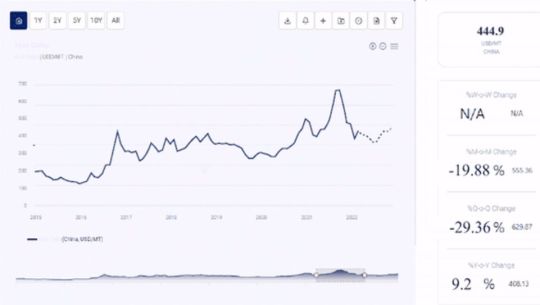
It is used in factories to empower the machinery used for manufacturing other products. Giant magnets use Electricity to charge themselves, which is then used to lift heavy materials. Activities like welding, drilling, and installing structures like gates and windows or empowering lifts require electrical power. It is a basic requirement in any public space, including offices, schools, buildings, hospitals, factories, manufacturing units, etc.
Additionally, household gadgets like MP3 players, televisions, air conditioners, toasters, refrigerators, phones, lamps, fans, and everything installed runs with the help of Electricity. It is required to process surgical procedures in the hospitals. It is required in the automobile or automotive sectors for charging batteries, especially in E-vehicles and trains. The giant power cells in space vehicles require electrical power to enable a continuous energy supply outside the atmosphere.
Key Players:
State Grid Corporation of China (SGCC)
Enel Group
General Electric Co
Korea Electric Power Corporation (KEPCO)
Tokyo Electric Power Company Holdings Inc (TEPCO)
EDF (Électricité de France) S.A.
RWE AG
News & Recent Development
Date: April 15, 2023- The New Delhi government announced continuing the Electricity subsidy plan, as Lieutenant Governor V.K Saxena approved the file on Friday.
About Us:
Procurement Resource offers in-depth research on product pricing and market insights for more than 500 chemicals, commodities, and utilities updated daily, weekly, monthly, and annually. It is a cost-effective, one-stop solution for all your market research requirements, irrespective of which part of the value chain you represent.
We have a team of highly experienced analysts who perform comprehensive research to deliver our clients the newest and most up-to-date market reports, cost models, price analysis, benchmarking, and category insights, which help in streamlining the procurement process for our clientele. Our team tracks the prices and production costs of a wide variety of goods and commodities, hence, providing you with the latest and consistent data.
To get real-time facts and insights to help our customers, we work with a varied range of procurement teams across industries. At Procurement Resource, we support our clients, with up-to-date and pioneering practices in the industry, to understand procurement methods, supply chain, and industry trends, so that they can build strategies to achieve maximum growth.
1 note
·
View note
Text
Powering the Nation: Navigating the US Power Market
The US Power Market is a vast and complex network that serves as the backbone of the nation's economy and daily life. It provides electricity to homes, businesses, industries, and institutions, driving economic growth and supporting a high standard of living. In this article, we will explore the US Power Market, examining its structure, energy sources, regulatory landscape, challenges, and the opportunities it presents for a sustainable energy future.
The Structure of the US Power Market
A Decentralized System
The US Power Market operates as a decentralized system, with a mix of public and private entities responsible for generating, transmitting, and distributing electricity. It consists of investor-owned utilities, municipal utilities, rural electric cooperatives, and federal power marketing administrations.
Energy Grids
The United States is divided into three major power grids: the Eastern Interconnection, the Western Interconnection, and the Electric Reliability Council of Texas (ERCOT). These grids are responsible for managing electricity transmission and distribution within their regions.
Energy Sources
Diverse Energy Mix
The US Power Market relies on a diverse energy mix that includes fossil fuels (coal, natural gas), nuclear power, and renewable energy sources (solar, wind, hydro, and geothermal). The shift toward cleaner and more sustainable energy sources is a prominent trend.
Renewable Energy
Renewable energy is on the rise, with wind and solar power leading the charge. Federal and state incentives, as well as public and private investments, have fueled the growth of these sustainable energy sources.
Regulatory Landscape
Federal and State Oversight
The US Power Market is subject to a dual regulatory framework. While the federal government oversees interstate transmission and wholesale electricity markets, states have jurisdiction over retail electricity distribution and local generation.
Regulatory Agencies
Key federal agencies that play a role in the power market include the Federal Energy Regulatory Commission (FERC) and the Department of Energy (DOE). State public utility commissions regulate rates, services, and the integration of renewable energy sources.
Challenges and Opportunities
Grid Modernization
The aging power grid infrastructure in many parts of the country presents a challenge. Modernization efforts are essential to improve grid reliability and integrate renewable energy sources effectively.
Environmental Concerns
Reducing carbon emissions and transitioning to cleaner energy sources are imperative to address climate change. The power market presents opportunities for reducing the environmental impact of energy production.
Cybersecurity
With increased digitization and connectivity, the power market faces cybersecurity threats. Robust measures are required to protect critical energy infrastructure from cyberattacks.
Conclusion
The United States Power Market is at a crossroads, balancing the need for reliable, affordable energy with the imperative of sustainability and environmental responsibility. As the nation continues its transition toward cleaner and more diverse energy sources, opportunities arise to shape a more resilient and sustainable energy future. For more insights into the US power market forecast, download a free sample report
FAQs
1. How is electricity priced in the US Power Market?
Electricity pricing in the US varies by region and is influenced by factors such as generation costs, fuel prices, demand, and regulatory policies. Wholesale electricity prices are determined in competitive markets, while retail prices are set by utilities and regulated by state authorities.
2. What are the main challenges facing the US Power Market in the transition to renewable energy?
Key challenges include upgrading and modernizing the aging grid infrastructure, integrating variable renewable energy sources, ensuring grid reliability, and transitioning from fossil fuels to cleaner energy sources.
3. What role do federal agencies like FERC and DOE play in the US Power Market?
The Federal Energy Regulatory Commission (FERC) oversees interstate electricity transmission and wholesale electricity markets, ensuring fair competition and reliability. The Department of Energy (DOE) plays a role in research, development, and policy related to energy resources and technologies.
4. How is the US Power Market addressing environmental concerns and reducing carbon emissions?
The market is addressing environmental concerns through the expansion of renewable energy, retirement of coal-fired power plants, increased energy efficiency measures, and carbon reduction targets in some states. Additionally, advancements in technology and grid modernization contribute to reducing emissions.
5. What is the significance of the three major power grids in the US?
The three major power grids in the US (Eastern Interconnection, Western Interconnection, and ERCOT) manage the transmission and distribution of electricity within their respective regions. They help ensure a stable and reliable electricity supply, especially in a country as geographically vast as the United States.
0 notes
Note

Say no more @onewigglyworm!
Here's a slightly slanting cheat sheet because that's just how I shoved it in the scanner:

Handwriting reveal!
Moving downwards
The most important (defining, I'd say) change as you go down any given group - that is, from the first period to the last one - is obviously the number of electron shells. This number increases as you move from the top to the bottom and that's essentially where all the trends in a group come from.
I think some of these properties are pretty clear and don't need much explanation, because they simply result from how the periodic table is arranged: that is, with an increasing atomic number (which is by definition the number of protons in the nucleus): mass number and atomic mass must also increase within groups, because more protons = more neutrons = the atom gets heavier. The same goes for the number of electrons (which has to be equal to the number of protons).
Adding more electron shells means the atomic radius increases which I also think speaks for itself. If you manage to put five sweaters on yourself, you'll look bigger than if you only wore one. (Except your sweaters don't have a charge, while electrons do: because they repel one another, the protons in the nucleus can't just pull them all in and the atom gets chonkier.)
Ionization energy tells us essentially how much energy we need to provide to ionize an atom, that is rip an electron off its outermost shell. Ionization energy must decrease within a group, because the farther down the group you go, the more shells an atom has and therefore the distance between the nucleus and the valence electrons of that atom grows. As that distance grows, the attractive force between protons and electrons decreases (y'know, Coulomb's law), so it becomes easier to remove an electron from that atom = you need less energy to do it.
It's pretty similar with electronegativity too. Electronegativity tells us how much an atom wants to hoard electrons, to put it colloquially. As the valence shell - the one that could accommodate extra electrons - gets farther from the protons, their attractive force decreases and it becomes harder to pull in more electrons.
And finally, metallic character means, well, how much an element acts like a metal vs nonmetal. To be more precise, it describes how easily an element gives up electrons: metals tend to give them up more easily (do you know how the metallic bond works? Metal atoms let go of their valence electrons and form a lattice of cations with said electrons permeating the whole lattice like a negatively charged cloud or sea). We already established that giving up electrons becomes easier as you move down a group, so that's why metallic character increases here as well.
Moving across
If the trends within a group (going up or down) come mostly from the changing number of electron shells, then a lot of the trends within a period (going left or right) come from the nuclear charge.
Again, some of these properties are rather obvious: I'm thinking about atomic number, mass number, atomic mass, and number of electrons here. I also explained these above and that explanation stands for groups as well as periods.
The rest, like I mentioned, comes from the increasing nuclear charge, because moving across the periodic table means adding more protons to the nucleus. These protons pull the valence electrons with increasing force (after all, the number of shells stays constant!) which decreases the atomic radius, but also makes it harder to remove the valence electrons (ionization energy increases) and easier to pull new electrons in (electronegativity also increases).
That last part is actually a littleeee bit more complex, because this is chemistry we're talking about, but I think it's enough to understand what's going on. If you're curious and ambitious though: look up shielding effect and effective nuclear charge.
I started doing chemistry at uni!!!! I’m having trouble with my chem lectures though… my lecturer seems to point out trends in the periodic table, and then? Doesn’t really explain why they’re there, which makes me feel really confused. Have you ever experienced something similar?
AAAA that's so cool I'm so happy for you!! Sorry about the professor though. Tbh I can't remember the way I was taught about the trends specifically, but it's one of those topics that often gets treated like this - no explanation, only memorization. And it drives me nuts bc all those trends come from *somewhere* and they aren't random! It's all actually pretty simple, why aren't you telling your students about it!!
Anyway. Cotton's Basic inorganic chemistry explains this topic pretty well if you want to do some reading by yourself, but also if you want me to explain this instead, no problem at all, just lmk. I legit have a whole unfinished post on the atomic/ ionic radii in my drafts lol
#i actually want to talk about shielding effect in that atomic radius post of mine#but when will i finish it?#hell if i know#anyway i hope this is understandable and helpful!#op
14 notes
·
View notes
Text

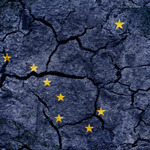


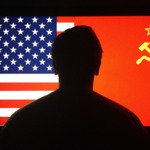
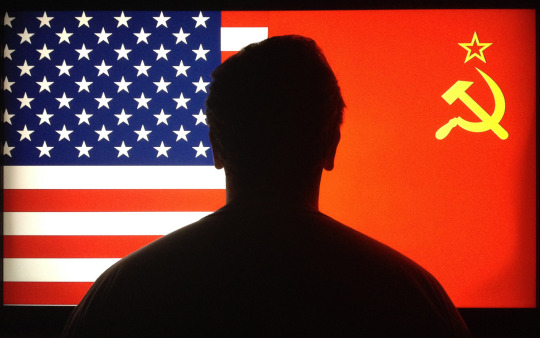
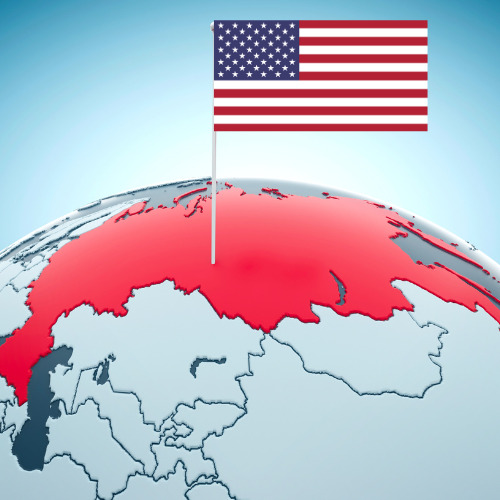




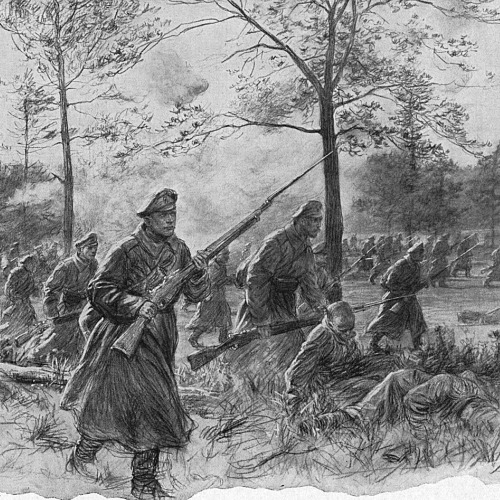
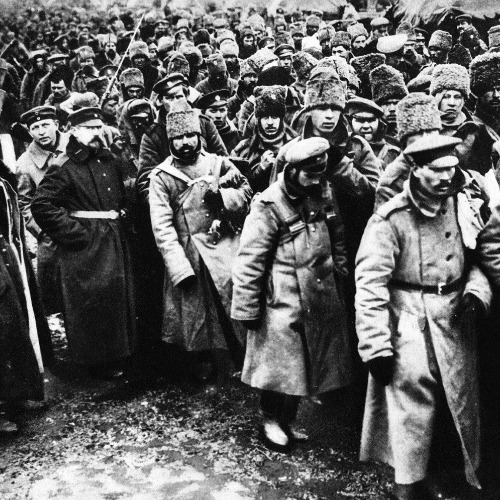












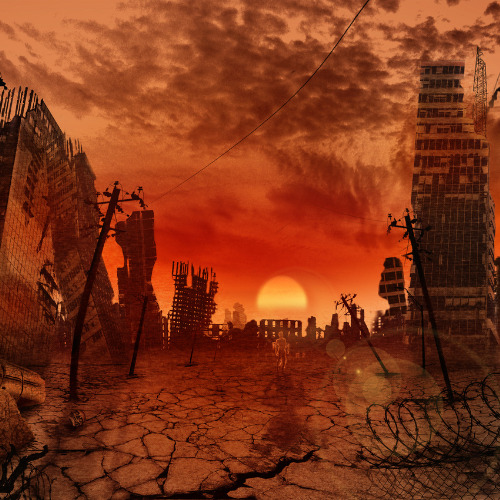

#nuclear symbol#garden bros nuclear circus#effective nuclear charge trend#naval nuclear laboratory#watts bar nuclear plant#nuclear power plants in nc#nuclear power plant nj#national museum of nuclear science & history#united nuclear#b83 nuclear bomb#north anna nuclear power plant#nuclear lamina#nuclear pore#nuclear sclerosis in dogs#mcguire nuclear station#nuclear cataract#nuclear wasabi#nuclear explosion gif#comanche peak nuclear power plant#oconee nuclear station#nuclear power plants in south carolina#nuclear sign#nucular vs nuclear#bomba nuclear#nuclear circus#which molecules do not normally cross the nuclear membrane?#calvert cliffs nuclear power plant#grand gulf nuclear station#nuclear physicist salary#nuclear medicine technologist jobs
2 notes
·
View notes
Text
Breaking of Now
"Those who can make you believe absurdities can make you commit atrocities"
That’s what I should have said to my sister when she asked genuinely what my problem with wearing a mask was. On this occasion I had gotten trapped and was pretty pissed about the whole situation. The week before one of the big retailer announced a mandate masks. Virtue signalling group think as far as I was concerned and assumed, wrongly that if i bought a little more I would have time to finally workaround them. The day the mandate took effect and the day i talked to her, I stopped by one of the more expensive less convenient workaround places to find a mask mandate. An couple hours latter i find out my main grocery store and the others options where going to mandate as well. Online is feeding a different beast and sending someone in my place is out sourcing my acquiescence. Trapped. In the end I just told her no one knows what they are doing (the failure to still count the deaths correctly), it's ridiculous (contradictory studies and disparate rules), that i suddenly didn't have a choice and it was going to take me a few days to adjust.
What was really going through my head was about USSR. “ It wasn’t the just the necessary lies it was the absurd little pointless ones that broke the spirit of the people” to paraphrase badly from a place I don’t remember. That is clearer statement of Voltaire and a simple explanation of why we shouldn’t lie. It’s not the childish notion that we should not because the truth is easier. Most see mask wearing a virtuous, for me it’s an affirmation of a lie, of several, of the ones closer to the roots. It’s not a herculean feat to see for me it’s just stupid hard wired reflexive contrarian angst , not hell no so much as why the hell . It leads you to question anti-vax, reduced fat, publish or die, replication crisis, Russell conjugation, virtues signalling, Overton window, attacks on moral relativism destroying gradation of sin and virtue, cognitive biases , government building as nation building, gas lighting, the church defending itself and the existence of God but not the moral order(not that it knew the difference), the irreconcilability of socialist thought and Jihadists with the west, big government as government playing god, half the people are dumper than the other, death of the common, the long list of what’s called the regressive left we focus so much on (more of a symptom than a cause),cultural relativism, common human behavior dressing up common human behavior as conspiracy, fragility of high civilization, economics standing in for moral order, monogamy, “perfect as your are” drowning the phoenix, nuclear family, woke rewrites hiding more subtle rewrites of western mythos, the prison of two ideas, deep silos of knowledge standing in for wider wisdom, and....
At some point you find yourself outside and not in some sort of edgy artsy way, not quite smart enough to figure out why no one else is there. I am sliding back into the hope I have gone insane. You deal with the whirling nightmare as little as possible, you don’t call it out at every turn, you don’t cheer it on, you don’t help it, and YOU DO NOT FUCKING LIE ABOUT IT.
So sitting in the parking lot,deciding if one of the innocent creatures that lives with me, approaching month four of the six the vet said she had left, gets the food she prefers at the moment... She had other food that was better for her anyway.., not that it matters now. I have a duty of care especially now. She won’t understand the problem or the cost to my honor, for lack of a better word. She will just miss the thing she is used to. In reality avoiding the mask is likely impracticality anyway. On the verge of throwing up, crying, punching the dashboard or screaming fuck over an over... a car pulls into the spot across from me and a woman starts unpacking a kid out or the back seat... none of the above. A few deep breaths and fuck it, the easy way it is. Never thought about actually punching a stranger or really anyone but the assigned finger wager at the door.... “I am a virtuous little citizen and those who know better know better” and not “we aren’t all writhing around in the liquefying corps of a great civilization” On queue they where still out of or ran out of again of the food I was after.
I didn’t feel anything brake that day. Thinking about it since something is missing. Maybe things are just numb and will come back in time. As of now thinking about what may have to be done in defense of a civilization worth defending against those that can not be reconciled with it, elicits little. The little emotional triggers that made question if I could if i had to, are gone.... I am pretty weak willed and was happy to stand on the side lines. Muse at what might untangle this mess. I am not a hard man by any imagining, but you made me lie exactly in the way that end civilizations. Not that mask work. Not that I was virtuous for doing so. Not that “we are all in this together”. Not that those in charge know. Not that anyone is in charge. Not that some version of normal coming. Not that this version of the west isn’t dead. It’s the lie that there isn’t a massive upheaval coming.
The mass of rubble , ideological and real that will have to be cleared. Unfortunately a fair amount of blood that is likely to be spilled. Driving now the phrase “ the ugliness of modern architecture” rings in my ears. Affordable little canvases of our own that last only a life time is not the worst thing, but churches in strip malls? Regardless if this is just contrivance of my head or not I have been pushed a few degrees off of where i was. For now, a reprieve as there is still the innocence creatures in my care. It sadly is not open ended.
This kinda of thing might not have pushed as hard as it did if the ground wasn’t already soft. Before all that a few thing had pushed me to wrap up what i was thinking and walk from my online musings. So. Brit Hume has been one of the perennial “ this is the most important election of our lives... til the next one” He and Thomas Sowell, calling it a point of no return have both come to the conclusion that it actually is. If Biden wins the next election wouldn't matter and any other road blocks would be gone.
Charlie Hurt calling it a make it stop election and latter Victor David Hanson questioning if a silent major exists leads one to believe that reason may have been locked out. That this is a who ever can convince enough people they can save them election. It really fell like the argument don’t matter at all. My suspicion is that if you had really solid polling and knew the outcome of a handful of thing you could easily predict this election now, nothing the candidate did would mean anything. I have kind of gotten used to the idea that thing are going to get well... bloody when the left takes power and finally nails the door shut behind its self.
I was under the illusion that there are a number people that “know” where that leads and would as a last resort raise the black flag. Someone “on the inter webs” I thought was one (for no good reason on my part) when asked opted for the benedictine option. “The monasteries survived”. The monasteries where not an existential threat to the king. Little literacy. little printing and no internet. The parallels to the Maoist and the jihadists to our current insurgents? rebels? look pretty clear. What makes anyone thing they going to be left alone by this “madness”. I got very worried. Those you think might keep Trump in power surrender to the mob.... and those who would fight might decide to hide..... A number of things start looking pretty frivolous.
Author Brooks among a legion of others, well meaning I am sure, prescribe kindness and reason and be patient. I short you don’t hug the guy with the suicide vest.... clear? For the jihadists anything said buy outsiders is meaningless, faith isn’t easily to question on the best of days. For the utopians, you can’t understands till it finally works and usually the censors and secret police help. To our little friends if your the oppressor you have no room to speak even if you think you understand how evil you are or your so oppressed that your don’t know what your taking about. It all insulated ideology, and all of it gets people killed. They haven't officially taken power so i guess you could try it one a time, cult deprogramming. However the cult isn’t living in the middle of nowhere, we are all living in it.
Jordan Peterson comes at it from a reasoned position focused more on the broader problems of the West. “Orientate your self properly,aye”. You raise yourself up and it raises those around you. Don’t think saving the West was at the top of his list when it all started Again a one at a time, bottom up approach. At the time I was sure it was far to slow and he never seemed to have a handle on American politics though he knows how badly societies can go wrong. He and many other I don’t think quite understood how bad intentioned the left really was, or how much the compromises made with them where always seeding ground. It seems like a great many people are still living there.
The other problem is the lack of a common. “if there is no common understanding there is no common sense” Mark Steyn if memory serves. My past understanding of the malignant “God is dead” quote was just that and it was a good thing. In part from Peterson, my understanding now is “the common belief in a common God / moral order is dead”. A strong civil society might be able to hold things together and let people do generally what they want....... as long as the reap the consequences of their choices. The problem comes when all choices become valid because there are no consequence . A strong moral order would have put the brakes on.
This is the general problem with the various libertarian imaginings. Over time it will always be a problem. Any significantly democratic organization will trend left or as to hear the left tell it “the long arch of history tend toward justice”... social justice.... popular judgement..... mob rule. Entropy. We all want to be nice and liked so we let the margins slide, leave a little wiggle room in the rules. Eventually it ticks over. Instead of allowing it’s restricting. I doesn’t matter now whatever the case. There is no way now to go any where near letting people reap their own consequences, what would the bureaucrats do with themselves.
So come at it from the other side? The moment the Enlightenment or the industrial revolution started the church was in existential peril. The less the average person need God to explain their day to day the less the ethereal wonder holds. The explosion of knowledge even if they didn’t understand all of it, become a surer path. Defense of the moral order was what was called for. The church defended itself and eventually the existence of God. I would like one of these fill in the blank “nationalist”, common good conservatives, new theocrat types explain to me how governmental policy is going to fix it? They seem to see it as a problem caused by the left. The left is just taking advantage. If it wasn’t them now it would be something else in a generation or four. Not only are they misidentifying the problem their solution is making it harder to solve. Setting government policy to favor what worked is not a guarantee it works going forward. There are plenty of good studies and sound arguments and some policies may work well. The problem, it introduces rigidity. It will help stave off the known worse, meanwhile staving off the unknown both for the worse and for the better. It slows the development of better.
There is this notion that the “left and the “right” should just get a divorce. The “left” will never be satisfied with that. There is as well the notion that we are to diverse to coexist. This is another result of the lack of a common. If a civilization or a country in this case, are bound together even loosely by a civil order an a moral order diversity isn’t a fatal issue. To say it isn’t possible is to reject the American experiment out right.
Those who have accepted a civil war is inevitable talk as if the fight will be to restore something? The war is between who? One side is usually the government. Not sure what is gained by pickling fight with Antifa et al.
I had thought after Ferguson leadership would have leaned it’s lesson. APCs for riot control, yes. For no knock warrant, not so much. It’s become abundantly clear I assume far to many things. We went from throw a water bottle at a cop, jail and the protest is over to everything is acceptable up until your try to burn people alive in a public building. As far as I am concerned those mayors and governors who allow this signed there own resignation letters.
It is has become clear Trump or likely any president can’t fix this. Trump specifically doesn’t have the tack to talk us off this ledge. Suspend the campaign for a week and talk about the consequences, the nature of and solution for the problem.... and never mention himself? I don’t know that and president would have the resources to declare an insurrection, deploy enough federal agents and national guard (assuming the governors allow it) and hold on til the local government went back to arresting the first bottle thrower. I doesn’t look like the decades long hold the “left” has had on these city is going to be broken by this, so no major change in policy that will stop this short term is coming. Those who decide to leave are likely to bring the same ideas that lead to the policies that lead to the chaos where ever they go. It’s not going to stay contained.
It sounded like there where the start of some defensive militia and there are always community deescalation groups. This is driven by policy fuel by ideology that can not be question (though they used to act as if it could). All solutions look to be outside our normal acceptable practice. Comment by Mark Steyn about Islam are instructive. Surrender, destroy, or reform. As with Islam this is a self fulfilling ideology. So? a form of colonization inside our country, an insurrection? Remove the mayors, city counsel and the prosecutors, none of which are doing their jobs. If the rule is that the feds don’t declare insurrections, and it is not declared as such then it is not. What about the governors? Then what..? What policies changes the culture? What are the markers for holding the next election? It is outside our norm, not so much for history in general.
If Trump wins whatever the left does including secession will be responded to by the federal government, our little city experiment aside. That at best will just reimpose the status quo. It is very unlikely to force the “left” ideology into retreat. If Biden gets elected? Play the city experiment out writ large . The constitution almost by definition can’t survive. So... just reprint the thing and put a new start date on it? What does that solve? Maybe I am not digging in the parts of the internet where these this are being hashed out. If they are I not sure it’s by the type of people I want running things.
A list of systemic grievances going into all this would be useful both as a guild for what comes after and as set of red lines. I am sure most libertarians could give you a library full of outrages. It is not the day to day bureaucratic nonsense that’s the problem or police outrages. It’s things like deferential impact, judicial realism, popular election of senators, and the supposed precondition in which regulation is allowed just to start. The last line may be when the left has easily won two or three elections in a row while everyone is being forced to do things they don’t want and never hear a word in the press about it. It may be to late by then. I believed that would be the result if Hilary got elected and it looks to be a certainty if Biden gets in.
Whatever the case maybe the violence has started and to what degree it escalate who knows. The idea that violence is never the answer was always a myth, one we are coming face to face with now. The fact is violence on very rare occasions is the only answer unless you are prepared to surrender everything, to live on your knees in agony. That is why the idea that the constitution is not a suicide pact never made any sense. We seeing it now to with the virus. “we must sacrifice everything even if it save one life”. What childishness. If you won’t die or worse live in pain for your principles they only hold until someone or thing threatens you with just that. If others know it your principles don’t mean much. Further more at societal level if leadership isn’t prepared to risk the live of civilian to protect those principles they aren’t going to last long either
All that in the end still solves nothing. You have beaten back the enemy for what? If violence comes or not we have to have something to go to, to strive for as a civilization. We are a fractured mess of half thoughts and endless “problems” to solve. We have no common understanding of what the moral order or any order is or should be. As is we are done.
“We are very unlikely to come up with entirely new definition or invention. We are very unlikely to invent new Gods, very unlikely to come up with new religion, ...very unlikely to be able to go anything this good again.” Douglas Murray.
A similar sentiment two plus years ago sent me in this direction.
“ Where the road we’re traveling takes us. Where do the above events and that one trend leave us? Not in a good place. Unless there’s a black swan somewhere down the line, we are heading inevitably towards a socialist America. “ “ I’m praying for a Black Swan. My prayers aren’t usually answered, though. That’s why I’m assuming that the American future will be totalitarian — either Marxist or Islamic — and that it might happen within my lifetime and will definitely happen within my children’s. “ - Bookworm
So what we are looking for is a Black swan, a new god, a new religion. In an ocean of ignorance with an occasional mist of wisdom let me see if I can puzzle this out a bit. First there is no puppet master just us. Though they took full advantage ,even the “left” isn’t the problem. We began to gain knowledge abundantly, with certainty if not ease. It distracted, if not overwhelmed the the ethereal of the church and rendered the judgement of the wise mute. So what do we need? We need to temper knowledge. We need not just the facts or the working of the parts we see. We need to pursue the truth, not exactly the truth. Not the truth of the tangible world or that of the ethereal. It is the truth of the moment. Our best understanding of the working of the two combined. And an understanding that some day it will change. And that is what we should pursue. The honest truth of what we know and a drive to find more. To try, succeed and fail, to find what is actually better. It is an extension of the road humanity was on before this diversion.
How to paint the picture? A discovered / revealed God/ devil/ saint/ mythic hero, a torch bearer along the path humanity has always been traveling. The path of our increasing understanding, the path that raised our civilization. A light that only shines on the path behind us, to illuminate the things we missed and on our figure calling us forward. One who demands that those who obscure the past repent. One who demands that those who misrepresent the path their on to get others to follow repent. One that asks us to forgive those who do and use the shape of their misdeeds to search for our own misunderstandings and mistakes.
In practice, a secular church that is neither. A voluntary body with neither the force of law or a claim to the moral order. A nondemocratic organization because the long arc of history tending toward social justice. An organization the is trusted to ask better questions. A group of people that will put themselves in the experiments in order and be brutally honest about the results.
So for instance the question about transmission of wisdom from one generation to the next is about how we raise children and that is about family and marriage. What is best? what do we really know? Follow the path all the way back. Romantic marriage is new, so why not practical or arranged marriage? We see the obvious problems with polygamy, with polyamory? Maybe some combination? maybe not one big romantic marriage but three,may be four people, one marriage is practical, one arrange, and one romantic. I have no idea. We can’t just default to the wisdom of religion or assume the recklessness of the “left”. Let Go. If it works or not we are better for knowing. We will have surer footing on the path ahead at least in the understanding of this moment.
If don’t like that formulation good. You build a black swan. If there’s a flock of them maybe one survives. Maybe we avoid generations of brutality. Maybe something of what we have done survives.
All I can do now is try to find a way not to live on my knees before anyone, anything, any ideology or idea. Try. That is all I can do.
Credit to those i stole ideas from that i can no longer remember if they're mine or not. I am going to put away my crayons down, shut my mouth give my mind a rest, deal with only what i must, and hopefully find a way to wonder at the world again.
or try to
12 notes
·
View notes
Text
Saturday, February 20, 2021
One of Ten in U.S. May Have to Switch Occupations Post Pandemic (Bloomberg) One out of every ten U.S. workers—about 17 million, all told—will likely be forced to leave their jobs and take up new occupations by 2030 as Covid-19’s after-effects destroy huge swathes of low-paying positions in a labor market that was primed for disruption before the pandemic. “Covid is a big disruptor,” Susan Lund, a Washington-based partner at McKinsey Global Institute, the consultant’s research arm, said in an interview. The 17 million Americans are part of the more than 100 million people worldwide that the institute forecast will need to leave their jobs and enter new lines of work by the end of the decade. That will amount to about one in 16 workers in the eight leading economies covered by the study, which includes China, Japan, Germany and the U.K., as well as the U.S. In a more-than-130-page paper, the institute sees the pandemic accelerating three trends that will continue to upend the labor market in the years ahead: more remote work and working from home; increased e-commerce and a bigger “delivery economy;” and stepped-up business use of artificial intelligence and robots. The forces Covid-19 unleashed mean there could be a lot less demand for front line workers in food service, retail, hospitality, and entertainment.
Politics Is Seeping Into Our Daily Life and Ruining Everything (Reason) Is there anything that politics can’t ruin? The answer, it appears, is a resounding “no” as partisan conflict creeps into all areas of American life. Our political affiliations, researchers say, obstruct friendships, influence our purchases, affect the positions we take on seemingly apolitical matters, and limit our job choices. As a result, many people are poorer, lonelier, and less healthy than they would otherwise be. “Political polarization is having far-reaching impacts on American life, harming consumer welfare and creating challenges for people ranging from elected officials and policymakers to corporate executives and marketers,” according to a new paper in the Journal of Public Policy & Marketing by researchers from Arizona State University, the University of Wyoming, and four other U.S. universities. People’s partisan identities influence the range of people with whom they are willing to have relationships, the brands they purchase, and the jobs they take. The finding that everything is becoming politicized builds on a growing mountain of data. Even before political tensions hit their current fever pitch, a 2018 survey found that “Nearly two-thirds (64 percent) of consumers around the world will buy or boycott a brand solely because of its position on a social or political issue” (the number for the U.S. was 59 percent). In 2020, a separate survey reported that “83% of Millennials find it important for the companies they buy from to align with their values.”
Cracked Pipes, Frozen Wells, Offline Treatment Plants: A Texan Water Crisis (NYT) Power began to flicker back on across much of Texas on Thursday, but millions across the state confronted another dire crisis: a shortage of drinkable water as pipes cracked, wells froze and water treatment plants were knocked offline. The problems were especially acute at hospitals. One, in Austin, was forced to move some of its most critically ill patients to another building when its faucets ran nearly dry. Another in Houston had to haul in water on trucks to flush toilets. But for many of the state’s residents stuck at home, the emergency meant boiling the tap water that trickled through their faucets, scouring stores for bottled water or boiling icicles and dirty snow on their stoves. Major disruptions to the Texas power grid left more than four million households without power this week, but by Thursday evening, only about 347,000 lacked electricity. Much of the statewide concern had turned to water woes. More than 800 public water systems serving 162 of the state’s 254 counties had been disrupted as of Thursday, affecting 13.1 million people, according to a spokeswoman for the Texas Commission on Environmental Quality.
Texas Good Samaritans Are Helping Out Those in Need Amid Deep Freeze (Newsweek) From owners turning their stores into warming centers, to a mystery man handing out $20 bills to shoppers in Houston, when faced with a crisis that has left 24 in the state dead, and millions without water and electricity, Texans have instinctively turned to helping others. One such figure is Raymond Garcia of Houston, Texas, who, upon realizing he had no power at home, decided to use his time helping others. He has been visiting people in his local community, helping with tasks such as fixing burst water pipes. "I'm just trying to help the Houston community," he told ABC13. "If I can help anyone else in my close range I will.” Garcia said he was inspired by the teaching of his mother, who died recently from COVID-19. "My mom always taught me, if you help and you give to people, God will always bless you," he said. "And you know what, I've been blessed." On Thursday, Jason Spenser, the Public Affairs Director for the Harris County Sheriff's Office tweeted about another remarkable character, a man dubbed a food 'angel'. When electricity outages meant the Foodarama near 18th Street and Ella Boulevard could no longer accept credit and debit card payments, the unidentified man began handing out $20 bills to people waiting in the line. Spenser estimated the man, who did not want to be photographed, handed out a total of $500. In Elgin, Texas, Monica Nava, owner of the Chemn Cafe, put in a big order just before the storm hit. Rather than see perishable items go to waste, she boxed them up with shelf-stable good into care packages estimated to have a value of $25 each. She gave the packages out to in-need members of the community and asked for those who could afford it to pay a donation.
Biden repudiates Trump on Iran, ready for talks on nuke deal (AP) The Biden administration said Thursday it’s ready to join talks with Iran and world powers to discuss a return to the 2015 nuclear deal, in a sharp repudiation of former President Donald Trump’s “maximum pressure campaign” that sought to isolate the Islamic Republic. The administration also took two steps at the United Nations aimed at restoring policy to what it was before Trump withdrew from the deal in 2018. The combined actions were immediately criticized by Iran hawks and are likely to draw concern from Israel and Gulf Arab states. The State Department announced the moves following discussions between Secretary of State Antony Blinken and his British, French and German counterparts, and as Biden prepares to participate, albeit virtually, in his first major international events with world leaders.
The Cuba bet (Foreign Policy) Cuba may still become Latin America’s first country to design a successful COVID-19 vaccine, with Phase 3 trials on one of its four vaccine candidates set to begin next month. If the shot performs well, it is expected to be exported to other Latin American nations. Cuba and Iran are partnering on Phase 3 trials of the Soberana 02 vaccine, and Mexico is exploring carrying out a Phase 3 trial as well.
It’s mud, mud everywhere in UK’s 3rd lockdown (AP) It’s apparently not enough for Britons to endure almost 120,000 COVID-19 deaths and face a new variant of the virus that scientists say is more contagious and more deadly. Not enough to struggle through a third lockdown in less than a year, a shutdown now in its ninth week in London with no end in sight. No, all of this has to come smack in the middle of Britain’s mud season, the time formally known as winter. While everyone in the U.K. is already lacking Vitamin D, the sun chooses to take a months-long work stoppage and named winter storms kept sweeping eastward across the Atlantic. Storm Bella marched in right after Christmas, bringing gusts up to 106 mph (92 kph) and rains that dumped 3.2 inches (80.2 mm) on a village in Scotland. A sodden, freezing version of a hurricane. Storm Darcy roared in last week from the opposite side, bringing an icy Arctic blast and the U.K.’s coldest temperature in 25 years. Unlike the southeastern U.S., which floods during the summer-fall hurricane season, Britain floods in the dead of winter, bringing hypothermia alongside germ-laden waters. Rivers across England and Scotland are bursting: 73 flood alerts were in effect on Friday alone. And this year, few gyms or schools are available for emergency housing for fear they will turn into COVID-19 factories. It’s a Dickensian time.
Spain arrests 80 in 3 nights of riots over rapper’s jailing (AP) Protests over the imprisonment of a rapper convicted of insulting the Spanish monarchy and praising terrorist violence were marred by rioting for the third night in a row Thursday. The plight of Pablo Hasél, who began this week to serve a 9-month sentence in a northeastern prison, has triggered a heated debate over the limits of free speech in Spain and a political storm over the use of violence by both the rapper’s supporters and the police. The rapper and his supporters say Hasél’s nine-month sentence for writing a critical song about former King Juan Carlos I, and for dozens of tweets that judges said glorified some of Spain’s defunct terrorist groups, violates free speech rights. Besides that case, the rapper has previously faced other charges or has pending trials for assault, praising armed extremist groups, breaking into private premises and insulting the monarchy.
Heating Up Culture Wars, France to Scour Universities for Ideas That ‘Corrupt Society’ (NYT) Stepping up its attacks on social science theories that it says threaten France, the French government announced this week that it would launch an investigation into academic research that it says feeds “Islamo-leftist” tendencies that “corrupt society.” While President Emmanuel Macron and some of his top ministers have spoken out forcefully against what they see as a destabilizing influence from American campuses in recent months, the announcement marked the first time that the government has moved to take action. It came as France’s lower house of Parliament passed a draft law against Islamism, an ideology it views as encouraging terrorist attacks, and as Mr. Macron tilts further to the right, anticipating nationalist challenges ahead of elections next year. Frédérique Vidal, the minister of higher education, said in Parliament on Tuesday that the state-run National Center for Scientific Research would oversee an investigation into the “totality of research underway in our country,” singling out post-colonialism. In an earlier television interview, Ms. Vidal said the investigation would focus on “Islamo-leftism”—a controversial term embraced by some of Mr. Macron’s leading ministers to accuse left-leaning intellectuals of justifying Islamism and even terrorism.
Myanmar protests stall fuel imports, drive up costs (Reuters) Myanmar’s refined fuel imports have stalled as protests over the Feb. 1 coup have shut the banks and government offices necessary for trade, while depreciation in the nation’s currency has driven up costs, four industry sources said. The economy of the Southeast Asian nation has been pulled up short by the biggest demonstrations since the “Saffron Revolution” of 2007, with protesters taking to the streets to denounce the military takeover and the unseating of a democratically elected government. Myanmar relies heavily on gasoline and diesel imports as its refineries are too small and old to meet its fuel needs. One of the sources said imports may make up as much as 98% of Myanmar’s fuel consumption. The “economy is almost at a standstill. Almost all government ministries are closed,” the source said. “Fuel supply is running low. (The country) might run out of oil in two months.”
Jakarta’s poor fear landslides from overflowing waste mountains (Nikkei Asia) The stench is overpowering, and it only gets worse as you approach the biggest landfill site in Southeast Asia. The green grass on the embankments of the road leading into the Bantar Gebang landfill on the outskirts of Jakarta quickly gives way to trash—stacked in piles as far as the eye can see, reaching the height of a 15-story building in places. Plastic bags, food packages, rubber wheels, cardboard, drink cans, and everything else that Jakartans consume and throw away can be found here—much of which turn to sludge when it rains. The site that constantly threatens landslides is also home to thousands of impoverished families. Around 20,000 people, according to an estimate by locals, make a living from collecting trash in Southeast Asia’s largest dump. More than 100,000 live in the landfill and its surroundings. Authorities are struggling to dispose of the massive amount of waste created by the 35 million people estimated by Statistics Indonesia to live the Jakarta metropolitan area. Landslides often occur at such sites. In February 2005, heavy rains triggered a slide at the Leuwigajah landfill, which serves the cities of Cimahi and Bandung in West Java, killing 157 people and swallowing two villages, Greenpeace Indonesia said. The Bantar Gebang landfill has also taken lives.
Israel expands its nuclear facility (The Guardian) Israel is carrying out a major expansion of its Dimona nuclear facility in the Negev desert, where it has historically made the fissile material for its nuclear arsenal. Construction work is evident in new satellite images published on Thursday by the International Panel on Fissile Material (IPFM), an independent expert group. The area being worked on is a few hundred meters across to the south and west of the domed reactor and reprocessing point at the Shimon Peres Negev Nuclear Research Center, near the desert town of Dimona. Pavel Podvig, a researcher with the program on science and global security at Princeton University, said: “It appears that the construction started quite early in 2019, or late 2018, so it’s been under way for about two years, but that’s all we can say at this point.”
2 notes
·
View notes